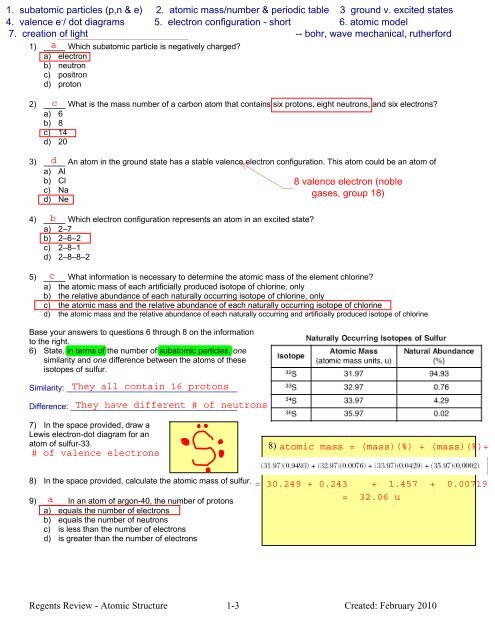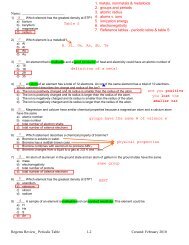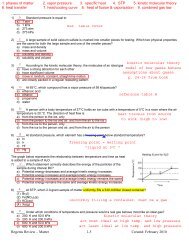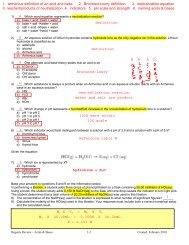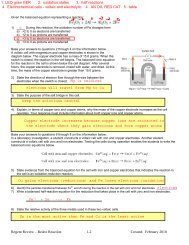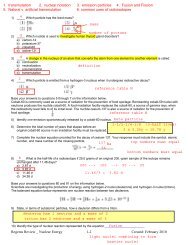Which notation represents an atom of sodium - Tully School District
Which notation represents an atom of sodium - Tully School District
Which notation represents an atom of sodium - Tully School District
Create successful ePaper yourself
Turn your PDF publications into a flip-book with our unique Google optimized e-Paper software.
Name: ___________________________<br />
1) ____ <strong>Which</strong> sub<strong>atom</strong>ic particle is negatively charged?<br />
a) electron<br />
b) neutron<br />
c) positron<br />
d) proton<br />
2) ____ What is the mass number <strong>of</strong> a carbon <strong>atom</strong> that contains six protons, eight neutrons, <strong>an</strong>d six electrons?<br />
a) 6<br />
b) 8<br />
c) 14<br />
d) 20<br />
3) ____ An <strong>atom</strong> in the ground state has a stable valence electron configuration. This <strong>atom</strong> could be <strong>an</strong> <strong>atom</strong> <strong>of</strong><br />
a) Al<br />
b) Cl<br />
c) Na<br />
d) Ne<br />
4) ____ <strong>Which</strong> electron configuration <strong>represents</strong> <strong>an</strong> <strong>atom</strong> in <strong>an</strong> excited state?<br />
a) 2–7<br />
b) 2–6–2<br />
c) 2–8–1<br />
d) 2–8–8–2<br />
5) ____ What information is necessary to determine the <strong>atom</strong>ic mass <strong>of</strong> the element chlorine?<br />
a) the <strong>atom</strong>ic mass <strong>of</strong> each artificially produced isotope <strong>of</strong> chlorine, only<br />
b) the relative abund<strong>an</strong>ce <strong>of</strong> each naturally occurring isotope <strong>of</strong> chlorine, only<br />
c) the <strong>atom</strong>ic mass <strong>an</strong>d the relative abund<strong>an</strong>ce <strong>of</strong> each naturally occurring isotope <strong>of</strong> chlorine<br />
d) the <strong>atom</strong>ic mass <strong>an</strong>d the relative abund<strong>an</strong>ce <strong>of</strong> each naturally occurring <strong>an</strong>d artificially produced isotope <strong>of</strong> chlorine<br />
Base your <strong>an</strong>swers to questions 6 through 8 on the information<br />
to the right.<br />
6) State, in terms <strong>of</strong> the number <strong>of</strong> sub<strong>atom</strong>ic particles, one<br />
similarity <strong>an</strong>d one difference between the <strong>atom</strong>s <strong>of</strong> these<br />
isotopes <strong>of</strong> sulfur.<br />
Similarity: ______________________________________<br />
Difference: _____________________________________<br />
7) In the space provided, draw a<br />
Lewis electron-dot diagram for <strong>an</strong><br />
<strong>atom</strong> <strong>of</strong> sulfur-33.<br />
8)<br />
8) In the space provided, calculate the <strong>atom</strong>ic mass <strong>of</strong> sulfur.<br />
9) ____ In <strong>an</strong> <strong>atom</strong> <strong>of</strong> argon-40, the number <strong>of</strong> protons<br />
a) equals the number <strong>of</strong> electrons<br />
b) equals the number <strong>of</strong> neutrons<br />
c) is less th<strong>an</strong> the number <strong>of</strong> electrons<br />
d) is greater th<strong>an</strong> the number <strong>of</strong> electrons<br />
Regents Review - Atomic Structure 1-3 Created: February 2010
Name: ___________________________<br />
10) ____ An electron in a <strong>sodium</strong> <strong>atom</strong> moves from the third shell to the fourth shell. This ch<strong>an</strong>ge is a result <strong>of</strong> the <strong>atom</strong><br />
a) absorbing energy<br />
b) releasing energy<br />
c) gaining <strong>an</strong> electron<br />
d) losing <strong>an</strong> electron<br />
Base your <strong>an</strong>swers to questions 11 <strong>an</strong>d 12 on the information below.<br />
In 1897, J. J. Thomson demonstrated in <strong>an</strong> experiment that cathode rays were deflected by <strong>an</strong> electric field. This<br />
suggested that cathode rays were composed <strong>of</strong> negatively charged particles found in all <strong>atom</strong>s. Thomson concluded that<br />
the <strong>atom</strong> was a positively charged sphere <strong>of</strong> almost uniform density in which negatively charged particles were<br />
embedded. The total negative charge in the <strong>atom</strong> was bal<strong>an</strong>ced by the positive charge, making the <strong>atom</strong> electrically<br />
neutral. In the early 1900s, Ernest Rutherford bombarded a very thin sheet <strong>of</strong> gold foil with alpha particles. After<br />
interpreting the results <strong>of</strong> the gold foil experiment, Rutherford proposed a more sophisticated model <strong>of</strong> the <strong>atom</strong>.<br />
11) State one conclusion from Rutherford’s experiment that contradicts one conclusion made by Thomson.<br />
12) State one aspect <strong>of</strong> the modern model <strong>of</strong> the <strong>atom</strong> that agrees with a conclusion made by Thomson.<br />
13) ____ <strong>Which</strong> electron configuration <strong>represents</strong> <strong>an</strong> excited state for a potassium <strong>atom</strong>?<br />
a) 2-8-7-1<br />
b) 2-8-7-2<br />
c) 2-8-8-1<br />
d) 2-8-8-2<br />
Given the bright-line spectra <strong>of</strong> three<br />
elements <strong>an</strong>d the spectrum <strong>of</strong> a<br />
mixture formed from at least two <strong>of</strong><br />
these elements:<br />
14) ____ <strong>Which</strong> elements are<br />
present in this mixture?<br />
a) E <strong>an</strong>d D, only<br />
b) E <strong>an</strong>d G, only<br />
c) D <strong>an</strong>d G, only<br />
d) D, E, <strong>an</strong>d G<br />
15) Describe the electrons in <strong>an</strong> <strong>atom</strong> <strong>of</strong> carbon in the ground state. Your response must include:<br />
• the charge <strong>of</strong> <strong>an</strong> electron<br />
• the location <strong>of</strong> electrons based on the wave-mech<strong>an</strong>ical model<br />
• the total number <strong>of</strong> electrons in a carbon <strong>atom</strong><br />
16) ____ <strong>Which</strong> two particles have opposite charges?<br />
a) <strong>an</strong> electron <strong>an</strong>d a neutron<br />
b) <strong>an</strong> electron <strong>an</strong>d a proton<br />
c) a proton <strong>an</strong>d a neutron<br />
d) a proton <strong>an</strong>d a positron<br />
Regents Review - Atomic Structure 2-3 Created: February 2010
Name: ___________________________<br />
17) ____ <strong>Which</strong> statement describes how <strong>an</strong> <strong>atom</strong> in the ground state becomes excited?<br />
a) The <strong>atom</strong> absorbs energy, <strong>an</strong>d one or more electrons move to a higher electron shell.<br />
b) The <strong>atom</strong> absorbs energy, <strong>an</strong>d one or more electrons move to a lower electron shell.<br />
c) The <strong>atom</strong> releases energy, <strong>an</strong>d one or more electrons move to a higher electron shell.<br />
d) The <strong>atom</strong> releases energy, <strong>an</strong>d one or more electrons move to a lower electron shell.<br />
18) ____ <strong>Which</strong> symbol <strong>represents</strong> <strong>an</strong> <strong>atom</strong> in the ground state with the most stable valence electron configuration?<br />
a) B<br />
b) O<br />
c) Li<br />
d) Ne<br />
19) ____ Each diagram to the right <strong>represents</strong> the nucleus <strong>of</strong> a<br />
different <strong>atom</strong>. <strong>Which</strong> diagrams represent nuclei <strong>of</strong> the same<br />
element?<br />
a) D <strong>an</strong>d E, only<br />
b) D, E, <strong>an</strong>d Q<br />
c) Q <strong>an</strong>d R, only<br />
d) Q, R, <strong>an</strong>d E<br />
Base your <strong>an</strong>swers to questions 20 through 23 on the information to the right.<br />
The <strong>atom</strong>ic <strong>an</strong>d ionic radii for <strong>sodium</strong> <strong>an</strong>d chlorine are shown in the table<br />
below.<br />
20) Write the ground state electron configuration for the ion that has a radius <strong>of</strong><br />
181 picometers.<br />
___________________________________<br />
21) Convert the radius <strong>of</strong> <strong>an</strong> Na + ion to meters. _____________________<br />
22) Explain, in terms <strong>of</strong> <strong>atom</strong>ic structure, why the radius <strong>of</strong> <strong>an</strong> Na <strong>atom</strong> is<br />
larger th<strong>an</strong> the radius <strong>of</strong> <strong>an</strong> Na + ion.<br />
Base your <strong>an</strong>swers to questions 23 <strong>an</strong>d 23 on the information below.<br />
The nucleus <strong>of</strong> one boron <strong>atom</strong> has five protons <strong>an</strong>d four neutrons.<br />
23) Determine the total number <strong>of</strong> electrons in the boron <strong>atom</strong>. ___________________<br />
24) Determine the total charge <strong>of</strong> the boron nucleus. ________________<br />
Regents Review - Atomic Structure 3-3 Created: February 2010


